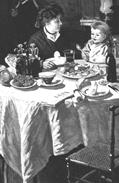Part iii. The things i like and dislike.
Unit 1. The things I like and Dislike. My Food.

Food is the first enjoyment of life.
Lin Yutang
Recommended grammar:
Verbals. Requests and preferences 
BUILDING-UP YOUR VOCABULARY
Meals in the U.S.
Meal Times
In the U.S., meals are usually served at the following times:
Breakfast: between 6:30 a.m. and 11:00 a.m.
Lunch: between 11:30 a.m. and 2:00 p.m.
Dinner: between 4:00 p.m. and 7:00 p.m.
Dinner is often the most substantial meal of the day, and usually includes a main course of meat, poultry or fish, accompanied by side dishes such as soup, salad and vegetables. Lunch in the U.S. tends to be a lighter meal (often a sandwich, yogurt or a lightentrée). Breakfast meals can vary from cereal and milk to eggs and pancakes or French toasts. Brunch, a common Sunday meal served between 10:00 a.m. and 2:00 p.m., is really a combination of traditional 'breakfast' and 'lunch' dishes. Scrambled eggs or omelets are often served along with other regular luncheon dishes. In many restaurants brunch is served from about 10 a.m. until mid-afternoon.
Common Dishes
Often Americans dine out, i.e. they go to different restaurants. Many foreign people think that Americans are always eating hamburgers in such restaurants. Now it’s proven that eating in such restaurants is not healthy enough. And the truth is that many people in the USA have become vegetarians, who eat little or no meat. Most Americans, however, like many different kinds of food. They especially like exotic foods, and restaurants that serve French, Arabic, Mexican, Japanese, Chinese and African cuisine are among their favorites.
There are a lot of foods in each category, depending upon which type of restaurant you go to (fast food or regular style, American or international cuisine, etc.). Below is a sample menu typical of some American-style restaurants:
Appetizers: nachos, chili, shrimp cocktail, raw vegetables and dip, finger sandwiches, cheese, etc.
Soups: French onion, chicken, vegetable, soup of the day
Salads: regular, Greek, chef, Caesar, spinach
Main Courses: steak, fried chicken with seasoned breading, broiled chicken, fish, hamburgers, pasta dishes, pizza, often served with vegetables or some other dish
Hot and Cold Sandwiches: combinations of ham, turkey, roast beef, chicken, tuna salad (tuna fish with mayonnaise and, sometimes, celery), egg salad (chopped hard boiled eggs with mayonnaise), cheese, lettuce, tomatoes, mayonnaise or mustard, etc., served on bread
Beverages: coffee, tea, soft drinks, mineral water, iced tea
Deserts: cakes, ice cream, frozen yogurt, fruit, etc.
Breakfast dishes: cold cereal and milk, warm cereal, toasts, yogurt, eggs, pancakes, French toasts, waffles, etc.
Americans also like to cook. And they don’t always make simple things. Some of them are real gourmets['guәmei], and they enjoy preparing fine meals. They spend thousands of dollars each year on cook-booksand cooking utensils to use in their kitchens. Like people in many countries, people in the US love to entertain, so they often invite guests to dinner.
When guests arrive, they find a table beautifully decorated with candles and fine china, because a meal is a more appetizing when it is served in pleasantsurroundings.When guests sit down to eat, they eat heartily. For many Americans, food that is cooked at home is most scrumptious of all.
Restaurants
There are two main types of restaurants in the U.S.: fast food and full-service restaurants. Fast food restaurants are called such because little time passes between the time a patron (= client) orders a meal and when he receives it. The style of fast food restaurants is much like that of a cafeteria. In a fast food restaurant, customers go up to a counter to order their meal. It is then placed on a plastic tray which patrons bring to a table. Fast food tends to be mass-produced. Items such as hamburgers, hot chicken sandwiches, pizza, and salads are typical of fast food fare.
Eating in a fast food style restaurant is much less expensive than eating in a full service restaurant. A typical dinner in a fast food restaurant costs from $4.00 to $6.00. Add a 6 to 10 percent tax levied on the cost of your bill. It is expected that customers will finish eating and leave the fast food restaurant within 30 to 45 minutes. In full service restaurants, customers don’t have to look for a table by themselves. They have to wait to be seated. The head-waiteror a waiter will necessarily come up to you, offer you a table:
Would you like a table by the window? – Yes, please, but not too close to the
entrance.
and show you to your seat:
This way, please.
The waiter hands a wine list to each customer. In first-class restaurants they have separate menus for wine and food (Here’s the menu.). Don’t be surprised if you don’t find a cloakroom in the restaurant. Most restaurants, and, of course, cafes and pubs, don’t have them. Customers usually put their coats on the back of their chairs or elsewhere.
First, you order your drinks:
Are you ready to order your drinks? – A gin and tonic for me, please.
What would you like to drink? – Scotch on the rocks, please.
Which wine would you like, sir? Which would you recommend? – We have
Chablis 1994. – Sounds good to me.
If you have ordered a bottle of wine, the waiter will bring one and first pour a little bit of wine into your glass. You should taste it, and if you find the wine good (which is most often the case), you should say “Yes” or just nod approvingly. Only then will the waiter fill your glass.
A few minutes after handing a menu to each customer, the waiter comes back: Are you ready to order? – I think we are.
What would you like to have for starters?/ What would you like to start
with? – I’d like to have green salads, please./ The same for me, please. /
I think I’ll start with soup/melon.
What would you like to have for the main course? - I’ll have steak and new
potatoes./ I’m at a loss. I don’t know what to order. Can you recommend
something to me?
Why not start with the shrimp cocktail, if you like sea food.–It’s fine with me.
At a restaurant the last course usually called ‘pudding’, ‘sweet’ or ‘dessert’ shouldn’t be ordered together with the starters and the main course. This is usually done later.
If you order tea and coffee together with the starters, the waiter will bring it at the beginning of the meal. That’s why if you want to finish your meal with tea or coffee, order it later.
Do you want any sweet? – A cup of coffee and cheese to finish with, please.
How about pudding? – Chocolate pudding for me, please.
 Dinner at full service restaurants can vary from $20 (including tax) in a less expensive restaurant, to $80 and more in an expensive restaurant. It is expected that customers will finish eating and leave a full service restaurant within an hour or an hour and a half.
Dinner at full service restaurants can vary from $20 (including tax) in a less expensive restaurant, to $80 and more in an expensive restaurant. It is expected that customers will finish eating and leave a full service restaurant within an hour or an hour and a half.
Could I pay now? - Here’s your bill, sir.
 Could I have the bill? – Here you are, madam.
Could I have the bill? – Here you are, madam.
The bill, please. – Here it is, sir.
In case something goes wrong you can say:
I’m sorry but we have been waiting for half an hour.
orSorry, but we did order 40 minutes ago.
or Sorry, but I asked for strawberry ice-cream, not
chocolate.
Tipping
In general, to express satisfaction with service, it is expected that customers will give wait staff at full service restaurants a tipof 10-15% of the bill for full meals if service is not already included. Don’t pay twice for the service: you should add 10-15 % only if there’s a stamped “Service is not included” on the menu or at the bottom of the bill. A small token is added if you are just having coffee or tea. Sometimes, wine stewardsare also given a tip of 15% of the bill. It is also customary to give bartenders a 10 to 15% tip. Also, small tips are usually given to coat check attendants (50 cents to one dollar), restroom attendants (about 50 cents) and car park attendants (also, about 50 cents).
It is not customary to tip in fast food restaurants. Customers are expected to dispose of the waste from their meals and stack their trays.
Water and Ice
Water from public sources is meant to be used for human consumption. In general, most people in the U.S. drink tap water,drinking bottled water for the sake of taste. There are certain places, however, such as Washington, D.C., New York, Los Angeles and other large cities where it is recommended to filter water before drinking.
 Any cold beverage you order at a cafe, fast food or regular style restaurant will be served to you with ice unless you request otherwise. Alcoholic drinks can be served on the rocks.
Any cold beverage you order at a cafe, fast food or regular style restaurant will be served to you with ice unless you request otherwise. Alcoholic drinks can be served on the rocks.
General expressions:
to start with, to make one’s order/ to order, to take one’s order, to be on/ keep to a diet, to pay a bill, to tip, to serve/ wait on, to lay (to spread) the table, to clear the table, to recommend, to prefer, to try/ to taste;
full course /three-course dinner, hors-d’oeuvres [o:’de:vr], table d’hote [‘ta:bl’dәut] (items/ dishes), a la carte [,a: la: ‘ka:t] (dishes/ items), buffet/ smorgasbord, portion, specialty, serving, bar, selection, restaurant, snack bar, food court, café, cafeteria, canteen, refectory (in British colleges), menu, head waiter, service, waiter (waitress)/ server, service charge, ash-tray, napkin, bill;
Hors d’oeuvres/ appetizers:
mushrooms, julienne, jellied fish (in aspic), caviar, crab cocktail, salad, sardine salad, mushrooms in sour cream;
Starters:
broth, chicken broth, soup, cabbage (ox-tail, noodle, pea, tomato, fish, onion) soup, purée, minestrone, thick soup, cream of mushrooms;
Main courses:
Fish dishes:
boiled beluga, spitted sturgeon, halibut in white sauce, pike-perch in white wine, stuffed fish;
Meat dishes:
mutton, beef stroganoff, rare beef, beefsteak, beef, goulash, assorted roast, meats, kidney pie, Yorkshire pudding, Chicken Kiev, liver, kidneys, pork, veal, hamburger, pork chop, tongue, ham, roast mutton, hotchpotch, cutlet, pâté, minced meat, sausage frankfurters/ wieners (AmE);
Poultry/ game/ fowl:
goose, turkey, chicken, duck, pheasant, chick, Kentucky fried chicken, roast chicken/ turkey/ goose/ duck;
Grain and milk dishes:
porridge, oatmeal, cereal, pasta, corn-flakes, kefir, half-milk, yogurt, milk, butter, cream, sour cream, cheese, Swiss/Dutch cheese, cottage cheese, cream cheese, curds;
Trimmings/ side dish/ garnish:vegetables and potatoes, new potatoes, mashed (boiled, fried, baked, roast, jacket) potatoes, rice, green peas, cabbage, cauliflower, egg-plants /aubergine, French fries, eggs (soft-boiled, hard-boiled, scrambled), omelet;Meat:
beef, kidney, liver , venison, veal, pork, mutton, lamb, fillet;
Fish:
cod, hake, plaice, mackerel, herring, sardine, trout, salmon, eel, pike, sole, halibut, tuna, catfish, pike-perch, carp, Baltic herring, Baltic sprat, sturgeon;
Seafood:
prawns, clam, shrimp, crab, lobster, crayfish, squid, mussels, oysters;
Vegetables:
artichoke, green pea, lettuce, cabbage, cauliflower, potato, onion, carrot, tomato, radish, bean, (a clove of) garlic, spinach, leek, zucchini, (bell) pepper, (a spear of) asparagus, corn (on the cob);
Fruit:
apricot, peach, pineapple, banana, grape, cherry, black cherry, pomegranate, grapefruit, tangerine, lemon, orange, pear, plum, apple, fig, avocado, mango, passion fruit, date, raisin, prune;
Berries:
(note that in English when saying about eating berries you use plural nouns, singular nouns mean ‘one berry’) strawberries, cranberries, gooseberries, raspberries, blueberries, blackberries, currants, watermelon, melon;
Nuts:
peanut, pecan, walnut, almond, hazel nut, pistachio nut;
Bread:
roll, croissant, bagel, sandwich, canapé, a loaf of bread, bun, dough, batter;
Dessert:
ice-cream, sundae, crème brûlée, pastry, sherbet, whipped cream, custard, doughnut, muffin, fudge, cup cake, scone, sponge cake, cookie, biscuit, cheesecake, jam, jelly/ jello (AmE), cake (it usually needs some filling, icing or topping), strawberry or apple tart, pudding, waffle flan, shortcake, pancake, gingerbread, crepe, maple syrup;
Soft drinks/ beverages:
lemonade, mineral water (still, fizzy), soda water, cider, Coca-Cola/Coke, tonic, juice;
Strong drinks/ spirits:
aperitif, dry or sweet wine, white or red wine, champagne, whisky (AmE whiskey), Scotch (whisky), cognac, brandy, vodka, rum, liqueur, gin, beer, moonshine;
Cocktails:
screwdriver (vodka and orange juice), grasshopper (pepper mint liquor, vodka and cream), whisky sour (whisky and lemon juice), Bloody Mary (vodka and tomato juice), Manhattan (dry vermouth, sweet vermouth and corn whisky); swizzle (rum and lemon juice); Highball (whisky and soda on rocks);
Hot beverages:
cocoa, regular coffee (with milk), instant coffee, black coffee, decaffeinated coffee, Irish coffee (with ice-cream), tea (with lemon or milk), herbal tea, hot chocolate;
Seasonings/ relishes/ dressings, spices and herbs:
sauce, ketchup/ catsup, mayonnaise, salad-dressing, (olive, sunflower) oil, lemon juice, dip, spices, vinegar, gravy, mustard, pepper, sugar, salt, cinnamon, vanilla, nutmeg, ginger, curry, dill, parsley, rosemary, thyme, chives, oregano, sage;
Flavours and tastes:
good, tasty, tasteless/ insipid, bland (neutral in flavour), bitter, sweet, hot/ spicy, sour, salty, sugary, sickly, savoury/ appetizing, unsalted;
Ways of cooking - verbs:
boil, fry, grill, roast, bake, skewer, knead, mix, sprinkle, dice, mash, pour, spread, peel, squeeze, roll, grate, crush, whisk, slice, carve, sift/ sieve, shop, dip, drain/ strain;
Ways of cooking - adjectives:
raw, fresh, fried, roasted, canned, smoked, stuffed with, boiled, roasted, stewed, grilled, marinated;
 Quality of food:
Quality of food:
greasy, underdone/ undercooked, rare, medium-rare, medium, well-done, overdone/ overcooked, tough/ stodgy, tender, done to a turn, more-ish (inf. you want to eat more), nourishing, cloying.
a) recipe fast food eat out dish bill cookery books
